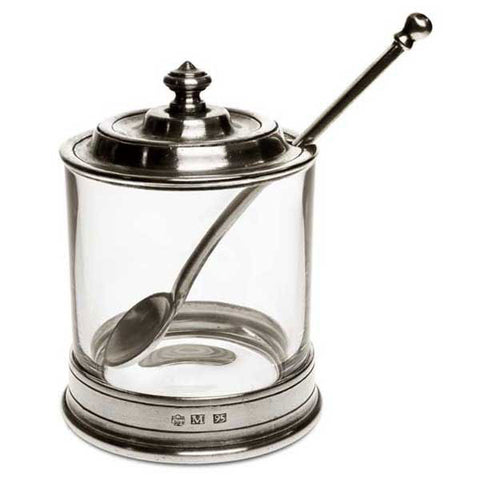Sirmione Jam Pot (with spoon) - 13 cm Height - Handcrafted in Italy - Pewter & Crystal
Handcrafted in Italy, this pretty pewter and glass lidded pot is part of the popular Sirmione range of pewter and crystal glasswares, and is a most attractive vessel for serving jam, at breakfast with croissants or toast, or with scones at tea-time, and comes complete with pewter Omnia spoon for serving and pewter lid for freshness.
Buying as a gift? Why not make it even more special with our engraving service?
This special little vessel lifts a simple sweet pleasure of jam, nature's berry bounty artfully transformed into a year-long treat, to a whole new level - grown-up jam sandwiches!
Jam, also known as ‘preserves’, ‘conserves’ (often with whole fruits) or ‘jellies’ (from French ‘gelee’ – to congeal, most often sieved to produce a clear mixture), is the most famous of all the fruit preserves. It is thought to have originated from the Middle-East, where cane sugar grew natively, and there is evidence that 1st Century Romans were using jams in their cooking, as the Romans were very keen on fruit, using in most meals, with influences from North Africa and the East.
It is likely that the 12-14th Century Crusaders brought jam back to Europe, and it was very popular by the late Middle Ages. Medieval European recipes often used cooked fruit within courses of meat and fish, as ancient physicians warned of eating certain fruits raw.
Following European exploration and colonisation of the West Indies and the introduction of sugar into the European palate and pantry, jam-making began properly in Britain in the 16th Century, slightly later than some other Southern European countries, such as Spain, whilst the Arabic and Caribbean civilisations had been using sugar to preserve fruits for generations.
Tudor monarchs were especially keen on jams, with a wide variety available, including deliciously historic sounding quince (early marmalades) and medlar jellies, dry sweetmeats or quidonies (like crystallised ginger) and wet sweetmeats or sucket( a cross between candied peel and jam – which is still produced in the Northern Aegean), more unusual for today’s palate. Louis XIV was also very partial to fruit preserves served in silver dishes at the end of a feast, sourced from the King’s own gardens and glass-houses at Versailles. Often banquets ended with candied fruits or jams to ‘close’ the stomach and aid digestion; the cooking in honey, or later sugar, removed the fear of ‘raw’ fruit as apothecary and confectionery blurred.
In the USA, New England settlers preserved fruits with honey, molasses or maple sugar and apple paring supplied the pectin necessary for the setting process. The first documentation of the term jam appear around the late 17th and early 18th centuries, most notably Mrs Mary Eales’s cookbooks; folklore insists the word this is derived from the French “j’aime”, meaning “I love (it)”, the children’s usual response on tasting.
Of course, it doesn't have to be jam within. The easy-wash glass pot means that all manner of condiments, from mustard to mint sauce, chilli sauce to children's favourite ketchup, can be served, depending upon the meal.
Size: Height 13 cm
Volume: 42 cl
Materials Used: Pewter, Crystal
Ref: CT0119561
Designer: Alberto Tabellini
100% Lead Free
All Cosi Tabellini Pewter is 100% lead-free, so it is totally food & drink safe, and is both EU and US FDA approved.
Packaging
Cosi Tabellini pieces come gift-boxed with a guarantee card and instructions on how to care for pewter.


